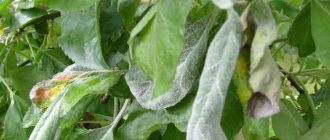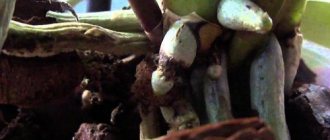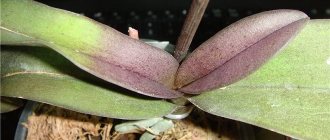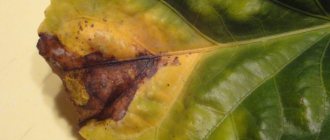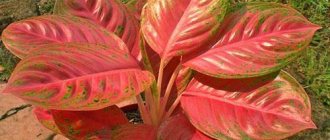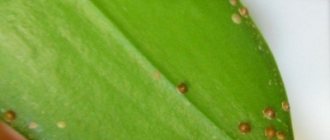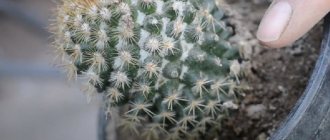One of the most attractive indoor plants for amateur gardeners in our country is cyclamen. An original plant with beautiful flowers has long and firmly taken its place on the windowsills of many apartments and has become a source of pride for their owners. However, this plant needs special attention, and responds to improper care with the appearance of various diseases that can negate all efforts to grow them. The only way to avoid cyclamen disease is to surround them with attention and provide proper care.
Description of the plant
You may be interested in: Does aloe bloom: description, flowering features, care, photos
Cyclamen is a herbaceous perennial with a tuberous thickened root. Perhaps it was due to the shape of its roots that it got its name. It grows naturally in the Mediterranean regions, but is better known as a houseplant.
This small, elegant flower with an interesting pattern on the leaves is valued for its high decorative properties. Its single flowers on long tall peduncles are distinguished by a variety of colors. While at first there were only species with red and white flowers, breeding has now produced varieties with different shades of pink, lilac and pale purple. The most common indoor flower is Persian cyclamen.
You may be interested in: Does aloe bloom: description, flowering features, care, photos
A distinctive feature of cyclamens is the fact that they bloom in the winter - from October to March.
Types of cyclamen flower
There are 20 types of cyclamen in nature (1). All of them live in the Mediterranean regions, but one, Cyclamen coum, is found in Russia - it can be found, for example, in the forests around Sochi and Gelendzhik. And at home, another species is grown - Persian cyclamen (Cyclamen persicum).
Cyclamen persica
This is a European look and one of the most spectacular. It has large heart-shaped leaves with a beautiful pattern on the outside. At the moment, there are many natural forms that differ in the size and color of the corollas.
Persian cyclamen. Photo: pixabay.com
European cyclamen
Also known as purple cyclamen (Cyclamen purpurascens) is found naturally in alpine forests. Its leaves are smaller than those of Persian cyclamen, and the flowers range in color from pink to purple. In mild European climates it is grown in gardens, in harsh conditions only in pots at home, but these plants are more likely for collectors.
European cyclamen. Photo: pixabay.com
The main causes of cyclamen diseases
All diseases of cyclamen occur, as a rule, due to non-compliance with the conditions of their maintenance. The main causes of diseases are:
- low air humidity;
- excessive watering;
- temperature violation;
- incorrect soil composition;
- improper care during the rest period;
- lack of lighting during the period of active growth and flowering.
Preventing cyclamen diseases is much easier than treating them. Therefore, the plant must be regularly inspected and, when the slightest signs of disease appear, promptly respond to them by adjusting the conditions of detention.
Propagating cyclamen flowers at home
In industrial greenhouses, Persian cyclamen is propagated by seeds, but this method is labor-intensive, time-consuming, and most importantly requires special conditions for maintaining seedlings: special turf-heather soil, cool conditions in winter (10 - 12 ° C), frequent watering and many other subtleties. In general, it is unrealistic to grow cyclamen from their seeds at home.
But you can propagate the flower by dividing the tuber, for example, cutting it into 2 - 4 parts. Each division should have several buds. The tuber sections should be sprinkled with crushed coal or ash - this will prevent rotting. Tubers should be divided in the fall, before they begin to grow leaves.
Maintenance during the rest period
In nature, active growth and flowering of cyclamens occurs in winter, which is characterized by cool weather and heavy rainfall. The plant perceives an increase in temperature as a signal of the onset of a hot, dry summer and begins to prepare for it. This feature is one of the reasons why problems arise with the content of cyclamens. In an excessively warm room, they stop blooming and try to shed their leaves, preparing for a dormant period. This fact must be taken into account when caring for a flower. Proper alternation of periods of growth with periods of rest and the creation of appropriate conditions during these periods will avoid many problems associated with cyclamen diseases and their treatment.
Rules of care
You may be interested in: Decembrist flower: how to propagate, care, photo
Cyclamen diseases will bypass you if the flower is provided with the following conditions:
- Correct lighting. During the active period, it should be bright, but exclude direct sunlight from entering the plant. Therefore, it is better to keep the flower in partial shade on windowsills facing east and west. On southern windows the plant will have to be shaded, and on northern windows there will be too little light for it.
- Temperature. In winter, during the period of active growth and flowering, the optimal temperature for cyclamens is +10 °C, the maximum limit is +14 °C. In summer, the ambient temperature should not exceed 25 °C. If possible, it is recommended to bury the pot with the plant in the garden, in a shaded place.
- Watering. It will require soft, settled water, the temperature of which should be a couple of degrees below room temperature. During the flowering period, the plant is watered so as to prevent the earthen clod from drying out or becoming waterlogged. Top watering is possible if it is done carefully so as not to soak the buds and tubers. It is better to water cyclamen from a tray. After holding the pot in the pan for one or two hours, drain the water from it to prevent rotting of the roots. When flowering ends, watering is gradually reduced, and with the onset of the summer dormant period, watering is extremely rare. From the beginning of autumn, watering is gradually increased.
- Air humidity. To increase it, the plant is periodically sprayed until the buds appear, after which the spraying is stopped so that the buds do not rot. To humidify the air, the pots can be placed on a tray with damp moss, expanded clay or pebbles so that their bottom does not touch the water.
- Feeding. When the plant is actively growing leaf mass and right up to the beginning of flowering, it is fed every two weeks with full mineral fertilizer. It must be remembered that an excess of nitrogen fertilizers can lead to rotting of the roots.
- The soil. Cyclamens should be replanted in soil consisting of leaf soil, humus, peat and sand. Soil acidity should not be higher than six, otherwise the likelihood of developing various fungal diseases increases.
Failure to follow these basic rules leads to various problems. Let's look at the main diseases of cyclamen with photos.
Prevention
Houseplants are difficult to cure. To prevent the flower from dying, it is advisable to prevent cyclamen diseases. Also, a lot depends on where you bought it. If done by hand, it is possible that the leaves, stems and flowers may be damaged by aphids and thrips. Never violate the recommended care conditions, since any deviation is fraught with the appearance of pests.
The plant is inspected every day . Do not miss a single leaf or flower when inspecting using a magnifying glass. If they find strange spots, they isolate him from others and begin to take measures to defeat the disease. Sometimes even treatment with insecticides does not destroy the pest the first time. Isn't it easier to take preventive measures?
Attention! To prevent pests from appearing, the soil before transplanting cyclamen is sterilized and steamed. For preventive purposes, it is treated with a solution of potassium permanganate.
It should be faint and its shade should be a faint pink. Potassium permanganate is an effective means of combating bacterial and fungal infections. Do not often fertilize with nitrogen fertilizers, which reduce the immunity of cyclamen.
We suggest you read about other problems when growing cyclamen, in particular about what to do if it withers or dries out. You can find out how to revive a plant that is dying for various reasons here.
Rot
The most common diseases of cyclamen are various types of rot.
- Wet rot. Flowers and leaves droop, and an unpleasant putrid odor appears. The roots also gradually rot. The cause of the disease is infection getting into cracks or wounds on the plant. The source of infection is a diseased plant or contaminated water. Unfortunately, in this case it will no longer be possible to save the flower. It must be destroyed to prevent infection of other plants. Preventive measures - compliance with the irrigation regime, avoiding waterlogging of the soil.
- Gray rot. The plant becomes soft and watery, and a gray moldy coating forms on it. The disease is provoked by high humidity levels and too low temperatures. To combat the disease, remove all diseased leaves and flowers and treat the plant with a fungicide. Make sure that the air is dry, to this end, ventilate the room, avoiding drafts. To avoid the appearance of gray rot, you need to prevent excess moisture and water from getting on the tuber and leaves during watering.
- Non-infectious rot of tubers causes yellowing and wilting of the leaves. The tubers become brown and soft. The diseased plant is destroyed. As a preventive measure, you need to use the right soil mixture, follow the feeding rules, moisten the tubers less often, especially in the heat, and do not plant them at great depth.
Let's look at other fungal diseases of cyclamen and their treatment with photos.
Where did the short flower stalks come from?
Watering regime is of considerable importance for cyclamen.
You should not allow the soil to dry out completely and, conversely, flood the flower until it becomes a swamp. The combination of such conditions, together with the low temperature of the plant, leads to shortened peduncles of cyclamen. If your flower has inflorescences blooming under the leaves on short peduncles, you need to adjust the watering.
Anthracnose
Increased temperature and humidity provoke the occurrence of this fungal disease. Outwardly it appears only with the beginning of flowering. If the flower stalks are affected by the fungus, they develop poorly, look twisted and turn yellow at the top. Buds do not appear, and existing ones do not bloom. Then the disease also invades the leaves. They turn yellow and dry out.
To save the plant, it is isolated, dried tissue is removed and treated with fungicides. Bring air humidity and room temperature in accordance with care requirements.
Diseases - description, photos, treatment tips
The plant sheds its leaves
Sometimes it’s not worth worrying about what to do if leaves and flowers have fallen from a plant. Because after the cyclamen has bloomed, it begins to prepare for the dormant period and sheds everything “excess”. It is very simple to determine this dormant period: the plant bloomed safely from September to March and dropped its flowers.
But if the shedding of leaves occurs in the middle of flowering, then it is worth reviewing the flower care points:
- lighting - there should be a lot of it, but you need to make sure that direct sunlight does not fall on the leaves;
- temperature regime - the air should warm up to a maximum of twenty degrees, but at the same time the temperature should not fall below ten degrees above zero;
- humidified air - but to maintain this condition, experts do not recommend spraying cyclamen; the best solution would be to place a container of water near the flower pot;
- hygiene - it is necessary to periodically wipe the leaves from dust, as well as promptly remove dead areas.
Silvery plaque or gray rot
This disease is caused by the fungus Botrytis cinerea. Typically, these fungi enter plants through contaminated air or water. But if normal conditions for growing cyclamen are provided, this harmful fungus will not be able to develop and will simply die.
However, when creating conditions for the development of Botrytis cinerea (high air humidity; low temperature, especially at night; too much soil moisture; improper watering, in which water gets into the growth points of leaves or buds), the flower may die, and in a very short period of time.
Symptoms of gray mold infection:
- the appearance of a silvery coating on shoots and leaf blades;
- the affected flower shoots begin to darken and die over time;
- the leaves on which mold has appeared gradually turn yellow and eventually disappear completely.
Treatment of gray rot:
- isolate the affected plant to prevent infection of neighboring flowers;
- remove already “sick” areas of cyclamen;
- ensure regular ventilation of the room, but this must be done in such a way that drafts do not form;
- reduce watering to a minimum, and completely eliminate spraying from care items;
- treat the plant with fungicides (this can be Euparen, Rovral, Ronilan).
Reference! If the disease is not detected in time, the flower is unlikely to be saved.
Fusarium
Another name is dry rot. The cause of the plant being affected by this disease is also a fungus called Fusarium. The advantage of this flower disease is that it develops quite slowly. And if you regularly inspect the flower, then there is every chance that the cyclamen will be revived.
The fungus destroys the tissues of the flower and then spreads to the vascular system, clogging the vessels of the plant. All this leads to the gradual withering of cyclamen.
Symptoms of the disease:
- leaf blades turn yellow, starting from the top of the plant;
- in this case, most often only one side is affected, while the second continues its development and flowering.
Treatment of fusarium:
- isolate the flowerpot with cyclamen;
- Spray with Topsin-M solution;
- water the soil with a solution of foundationazole.
Important! Very often, the Fusarium fungus remains in the soil, so it is better to replace it with a new one or treat the old one. This can be done by placing the soil in the microwave for a few minutes or in the freezer for a few hours.
Wet rot
The causative agents of this disease are Erwinia bacteria. Cyclamen can become infected in several ways:
- through a nearby flower;
- through contaminated water;
- through mechanical damage to different parts of the plant.
Symptoms:
- sudden wilting of leaves and flowers;
- unpleasant odor that comes from the rhizome;
- Root rotting.
There is still no really helpful way to cure a plant from wet rot. Therefore, the only correct solution would be to destroy the flower along with the soil in which it grew, so that the bacteria do not spread to other plants.
Anthracnose
The disease is caused by a fungus from the genus Gloeosporium . But the following incorrect care points are already developing anthracnose:
- too high air temperature (over 20 degrees Celsius);
- too humid air.
For a very long time, this disease may not make itself felt. Anthracnose appears only when a flower shoot appears on the plant. It grows in a crooked shape, develops poorly, and then begins to turn yellow from the top. The buds never grow and even the existing ones eventually do not bloom. Then the disease spreads to the leaf blades, which also turn yellow and dry out. This also applies to young leaves.
Treatment:
- isolate the plant;
- normalize the humidity level in the room - it should be slightly reduced;
- remove dried areas of cyclamen;
- treat with fungicidal preparations three to four times with a break of 5-7 days.
Rhizoctoniosis
Rhizoctonia rot is caused by the fungus Rhizoctonia solani JG Kuhn. Both flowers and those already formed can be influenced. cyclamens. Infecting fungi are localized in the soil and from there they infect the root system.
Good conditions for propagation of flexiweed are:
- high air temperature;
- too humidified air;
- overly active feeding with fertilizers.
Symptoms:
- the appearance of depressed pigmentation of a dark color both on the above-ground part and on the underground part of the flower (this pigmentation tends to multiply very quickly);
- At the sites of pigmentation, a fungal coating forms, which can be white or gray.
Treatment:
- to prevent the appearance of rhizoctonia rot, special attention should be paid to the choice of soil - it should allow the roots to “breathe” - and loosen the soil as often as possible;
- stop watering completely;
- replace the soil with a new one;
- treat cyclamen with fungicides (spraying).
Attention! Rhizoctonia rot spreads very quickly and kills the plant at the same rate, so you need to act immediately.
Late blight
Caused by the fungus Phytophthora. Favorable conditions for the development of this fungus are absolutely identical to those conditions that provoke the development of rhizoctonia rot, so we will not list them.
Symptoms:
- sheet plates lose their strength and tightness;
- the lower leaves and peduncles begin to dry out, followed by other parts of the plant;
- the root tuber becomes rotten.
Treatment:
- do not forget about the importance of soil quality: it must ensure air circulation;
- temporarily stop moistening the soil;
- get rid of the contaminated substrate;
- treat the affected plant with the following fungicides: Profit Gold, Ridomil, Previkur.
Fusarium leaf wilt
The disease is caused by the fungus Fusarium oxysporum Schlecht. This particular mushroom thrives in very dry soils that lack nutrients.
Important! Sudden changes in soil dryness and moisture cause the active development of the fungus Fusarium oxysporum Schlecht.
Symptoms:
- yellowing and drying of the lower leaves of cyclamen;
- damage to the root system;
- then the flower shoots also become infected.
Treatment. Fusarium wilt is very difficult to treat . In most cases, even fungicides do not help control this disease. Therefore, it is necessary to take preventive measures: carefully select the soil, avoid elevated temperatures and sudden changes in soil moisture levels.
Late blight and other fungal diseases
One of the most common diseases and pests of cyclamen is the Phytophthora fungus. Favorable conditions for its development include too high temperature and air humidity, as well as excessively active feeding with fertilizers.
Externally, the disease manifests itself as a loss of elasticity and strength of the leaf plates, which later begin to dry out. The tuber becomes rotten.
To combat late blight, you need to temporarily stop watering, completely replace the soil in the pot, treat the plant with fungicides and maintain the required temperature and humidity in the room.
Dangerous fungal diseases of cyclamen also include rhizoctonia and fusarium. Methods for treating and preventing the former are similar to the treatment of late blight. Fusarium is very difficult to treat even with fungicides. It is easier to prevent it by adjusting the conditions in which the flower is kept.
Common diseases and pests of cyclamen, and why it does not bloom
With proper care, cyclamen is rarely susceptible to disease and pest infestation.
As many experienced gardeners have noticed, most often old plants that are more than six years old get sick. Large tuber size increases susceptibility to disease. Also, various problems when breeding cyclamen can arise due to high humidity or dry air in the room, as well as inappropriate temperature of the plant.
The appearance of various diseases can be provoked by waterlogging of the soil, an excess of nitrogen in it, an incorrectly selected pot during transplantation and location, or an infected substrate.
Viral diseases
Among the diseases and pests of cyclamen, photos of which are presented below, special mention should be made of viral infections:
- Leaf bronze virus manifests itself as deformation of leaf blades, a brown pattern on them and necrosis of veins and tissues. Sick plants are destroyed.
- Ring mosaic virus. The leaves develop ring patterns that resemble fingerprints. The veins harden and the leaves crack. Sick plants should be destroyed.
The carrier of this virus is thrips. To prevent infection, special sticky traps for these pests are hung in places where plants are kept. In addition to thrips, there are other pests. Cyclamen diseases and the treatment of ailments caused by them also require special attention.
Popular questions and answers
We asked popular questions about cyclamens to agronomist-breeder Svetlana Mikhailova.
How to choose a cyclamen flower?
The most important thing is that it is healthy - the leaves are elastic, without signs of rot, spots or yellowness. By the way, in Soviet times in greenhouses the quality of cyclamens was checked this way: they turned the pot upside down, and it had to stand on the leaves without bending them.
Why does the cyclamen flower turn yellow?
As a rule, these are maintenance errors - too hot and dry air. Diseases and pests, such as spider mites, can also cause yellowing leaves.
Why does the cyclamen flower wither?
The most common reason is that it was not watered on time. But if the leaves suddenly wither and do not stand up after watering, it means that the plant is affected by wet rot.
How to store cyclamen tuber?
There is no need to remove the cyclamen tuber from the pot - it should be stored directly in the ground. The pot should be sent to a dry, dark place with a temperature of 15 – 20 °C. And lay it on its side. Once every 2 weeks the soil needs to be watered a little.
Sources
- Cyclamen // The Plant List https://www.theplantlist.org/1.1/browse/A/Primulaceae/Cyclamen/
- Tyuvetskaya M.A. The rhythm of seasonal development of species of the genus Cyclamen l. (Primulaceae) in the conditions of greenhouse culture // Bulletin of the Moscow Society of Naturalists. Department of Biology, 2013 https://cyberleninka.ru/article/n/ritm-sezonnogo-razvitiya-vidov-roda-cyclamen-l-primulaceae-v-usloviyah-oranzshereynoy-kultury
- Tulintsev V.G. Floriculture with the basics of selection and seed production // Stroyizdat, Leningrad branch, 1977, 208 p.
- State catalog of pesticides and agrochemicals as of July 6, 2022 // Ministry of Agriculture of the Russian Federation https://mcx.gov.ru/ministry/departments/departament-rastenievodstva-mekhanizatsii-khimizatsii-i-zashchity-rasteniy/industry- information/info-gosudarstvennaya-usluga-po-gosudarstvennoy-registratsii-pestitsidov-i-agrokhimikatov/
Pests and their control
The most common pests of cyclamen are:
- Aphid. These insects are capable of literally sucking all the juices out of a plant in a matter of days. In large quantities, aphids cover the flower like a coating. As a result, it becomes deformed and may die. The plant should be washed under a strong stream of water and treated with an insecticide.
- Cyclamen mite. Due to its microscopic size, its appearance can only be noticed when a lot of individuals accumulate in one place. A cluster of yellow dust appears to form on the inner surface of the leaf. As a result, the leaves begin to change at the edges, the stems curl, and the buds fall off. To save the plant, you must immediately remove all its affected parts and spray it with an insecticide.
- Root root nematodes. Signs of their appearance are stunted growth and the formation of nodular swellings on the root that resemble beads. Unfortunately, such a plant must be destroyed.
Prevention of cyclamen diseases consists of proper care and compliance with all necessary maintenance requirements.
Source
Insect pests on cyclamens
Despite the fact that cyclamens are indoor plants, they, like outdoor flowers, are threatened by insect pests.
Aphid
Despite the very small, no more than 2 mm, size of the soft, wingless body, aphids can significantly weaken the plant. It is also unpleasant that aphids not only feed on plant juices, but also settle on buds and flowers. Due to aphid infestation, if the buds open, the flowers turn out small and twisted.
It is quite easy to spot aphids on a plant. Especially if their body color is not green, but black, gray or orange. If the plant has stopped growing, the leaves have lost their bright color, the flowers are deformed, and the entire bush looks as if it is sprinkled with dandruff or doused with sticky syrup, then this is a reason to inspect it for aphids. Particular attention should be paid to the lower part of the leaves.
Aphids are also dangerous because pathogenic fungi easily settle on plants weakened by them.
To kill aphids, you must first mechanically remove adult insects with a swab. and then spray with a solution of the drug "Aktara".
Thrips
The presence of wings on thrips helps them quickly and easily cover distances and infect indoor plants. It is quite easy to spot the pest. It has a light body and, crawling along the plant, it leaves a wet, shiny thin trail.
Both larvae and adult thrips cause damage to the flower. Larvae laid by females form into adult insects in 20 - 25 days. Bushes infected with thrips stop growing, leaves and flower stalks become deformed. Strange light dots may appear on the surface of the leaves. If you turn the leaf over, you can see colonies of larvae. With an excessive increase in the number of these pests, the leaf becomes almost completely discolored, then turns brown and dries out. A factor that contributes to the infection of a flower by these pests is placing pots with cyclamen in very warm and damp rooms.
In addition to direct harm, thrips can indirectly cause cyclamens to become infected with fungal diseases. To reduce the risk of infection, in spring and summer, when windows are open, you can hang adhesive tape traps.
If an infection has occurred, then you can help the flower by spraying it with Aktara.
By following the above recommendations, you can not only grow healthy cyclamen, but also, if necessary, save a sick plant from death.

